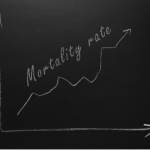NEW YORK (Reuters Health)—Systemic lupus erythematosus (SLE) mortality has declined during the past 46 years in the U.S.—but more slowly than mortality in the general population, according to a nationwide study.
“Based on our experience in the clinic and according to previous reports showing improvement in the short-term (five- to 10-year) survival in lupus, I was expecting to see a greater decrease in lupus mortality rate over time,” Dr. Ram R. Singh from University of California, Los Angeles, tells Reuters Health by email. “So, I was surprised to find that lupus mortality rate has decreased only 24% in a 46-year period, whereas mortality from all other causes has decreased 44% in the same 46-year period.”
“I was most disturbed by the finding that (the) lupus death rate relative to (the) death rate due to all other causes (the ratio) is actually 35% higher in 2013 than in 1968,” he says.
As a result of diagnostic and therapeutic developments, five- and 10-year survival rates for SLE patients improved from less than 50% in the 1950s to more than 90% in the 1980s.
To explore what has changed since then, Dr. Singh and colleagues examined age-standardized mortality rates (ASMRs) for individuals with or without SLE from 1968 through 2013, focusing on trends by sex, race/ethnicity, and geographic region.
The findings were published online Oct. 30 in Annals of Internal Medicine.1
The ASMR for SLE decreased from 0.45 per 100,000 persons in 1968 to 0.34 per 100,000 persons in 2013, a relative decrease of 24.4%.
During the same period, the non-SLE ASMR declined by 43.9%.
The ratio between SLE and non-SLE mortality increased between 1975 and 1998, but showed a sustained decrease after 1998. However, in 2013, the ratio remained 34.6% higher than in 1968.
SLE mortality stratified by race/ethnicity was higher in women than men in all racial/ethnic groups, whereas the adjusted odds ratio (SLE to non-SLE) and mortality differences were largest in non-Hispanic black people and smallest in non-Hispanic white people.
For all racial/ethnic groups, SLE mortality risk was greater in all other geographic regions relative to the Northeast, except for non-Hispanic black persons in the Midwest and Hispanic persons in the South and Midwest.
SLE mortality risk was more than three times higher among patients age 65 or older than among younger patients.
“Non-white persons and older individuals with lupus have a relatively higher risk of death from lupus and may need additional attention,” Dr. Singh says.
“This report paves the way for future studies to identify persons of specific race/ethnicity, sex, age group, and of socioeconomic status and behavior patterns living in certain counties who are at the highest risk of death from lupus,” he says. “So, the counties could focus their resources to target these high-risk populations. This concept is called ‘precision public health.’”
“The good news is that both lupus death rate and lupus death rate relative to non-lupus death rate (ratio) have begun to decrease since the late 1990s at a relatively high pace: (the) lupus death rate has decreased 2.7% every year since 1999, and the ratio has decreased 1.2% every year since 1998,” Dr. Singh says.
“Assuming that this recent decrease is not due to some unforeseen factor, such as a rapid decrease in the incidence of lupus over the past two decades, our results suggest that the management strategies that we are taking seem to be helping lupus patients,” he says. “These management strategies include an aggressive approach to monitor lupus disease activity, judicious use of induction and maintenance regimen of immunosuppressive medications, including mycophenolate, judicious use of corticosteroids, use of hydroxychloroquine, and screening for complications such as atherosclerosis.”
Dr. Luis Ines, director of the lupus clinic at Centro Hospitalar Universitario de Coimbra, in Portugal, tells Reuters Health by email, “Clinical progress in SLE is lagging behind other diseases as a whole. Outcomes can probably be improved by extending access to best standard of care to more patients.”
“There is an unmet need for new drugs and treatment strategies in SLE, that is becoming larger as compared to other diseases,” he says.
Dr. Cezar Caldas from Centro Universitario do Estado do Para (CESUPA), Belem, Brazil, recently reported on SLE mortality there. He tells Reuters Health by email, “As in Brazil, there are regional discrepancies, possibly related to socioeconomic conditions and access to health services. It should be a warning to the authorities, understanding that there are subpopulations that require more attention to reach better health levels.”
Dr. Caldas recommends giving “attention to these subpopulations, especially those older than 65 years, where thinking about the diagnosis of SLE may be more difficult.”
Reference
- Yen EY, Shaheen M, Woo JMP, et al. 46-year trends in systemic lupus erythematosus mortality in the United States, 1968 to 2013: A nationwide population-based study. Ann Intern Med. 2017 Oct 30. doi: 10.7326/M17-0102.

